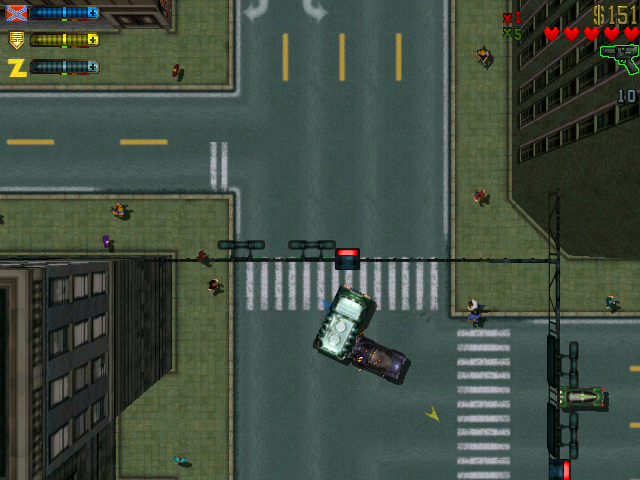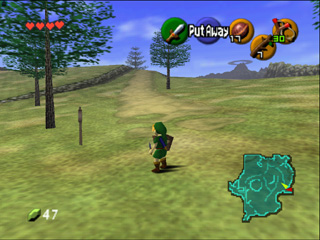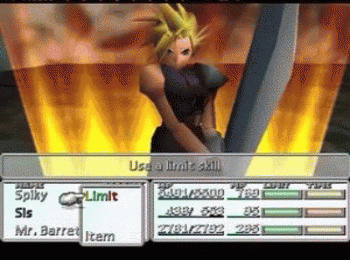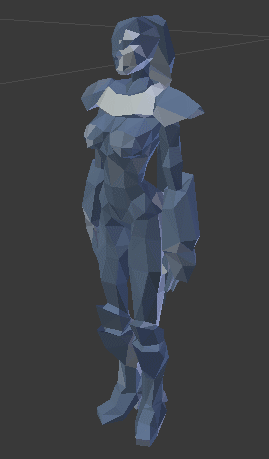Toadthemushroom
Member
That's pretty cool! Whole map reminds me of a huge Zelda-like dungeon area.
Yeah, the separate areas weren't that big, but were all connected to each other, like in Souls games.
Here's the map.
It's pretty amazing, that you could travel all across that without loading pauses on the PS1. To my understanding the next area was loaded in the background, when you travelled inbetween them.
That's pretty cool! Whole map reminds me of a huge Zelda-like dungeon area.
Trees don't look like that by you?Zelda would cry if you did.

Hahaha, what is this? Random PC port vs custom build game specially for the system?Let's give examples of open world games from the generation that was:

Grand Theft Auto 2 (Pretty sure this is a suped up port too)

Legend of Zelda: Ocarina of Time
Hahaha, what is this? Random PC port vs custom build game specially for the system?
That's nice.
This; blurrovision and low fps don't help N64 titlesN64 was definitely more powerful, but all those games using that AA... I feel like PS1 visuals have aged somewhat better.
That's pretty cool! Whole map reminds me of a huge Zelda-like dungeon area.
Yeah not enough games used a similar streaming technique on PS1, the long loading times were something that definitely fueled the fanboy wars back in the day :b
That's why there are so many corridors in that map also. Metroid Prime uses a similar method but just masks the loading with the delayed door opening.
This thread is 4 years old btw
All I want to know is how they managed to fit a game the size of Super Mario 64 on around an 8mb cartridge while Crash Bandicoot is about 400mb
I don't know how compression works
And textures aside, Conker is rendering far, far more on-screen, has animated environments/objects, realtime shadows, much more advanced lighting and particle effects and so much more.
DewPrism's environments are entirely static, more barren and the character models are basic (no moving mouths like Conker's), and the lighting is flat. Heck, that's cutscene gameplay and the characters don't even have simple circle shadows.
Yep, Conker pretty much pushed the N64 showing off what it could do.Yes of course. Not even a PS game can stand in front of Conker:
- flawless draw distance
- some textures are unmatched
- amazing dynamic shadows who follows different lights, surfaces, stairs, walls, etc.
- dynamic lighting in every single centimeter of game, sometimes tons of different dynamic lighting at the same time
- multilayered transparencies
- mirrored surfaces which reflex everything
- ears animation
- fantastic elaborated tail animation which follows movement and sensations of the character
- facial animation, Conker's perfectly textured blended eyes moves and look everywhere, Conker has tons of different facial expressions in-game and during cut-scenes
- lip synch unmatched in that generation
- clothes animations
- motion blur
- NPC characters with tons of animations and lip synched
- environment animations
- water physics (in War stage)
-smooth frame rate (only occasional drops but every reviewer agrees that are never annoying)
- free cameras
And much more.
Add the game doesn't show not ever one cartridge limit (more than two hours of speeches, tons of sounds effects, amazing variety of musics, Dolby Surround, etc.) and you don't have loading times.
Conker is not only the best graphics game of the gen, it's also technically the best game of the gen.
And I didn't even describe every detail. Conker graphical features literally deserve a dedicated description for each level. I never manage to play it without noticing some new amazing features.
Only people very ignorant in matter of graphics can think that N64 doesn't have the best graphics of the entire generation.
Look this video after 5m30s and you will see all the effects on screen at the same time:
https://youtu.be/J-2UuMSzPro
Was Zelda really an open world game? It was more like a series of hubs where I think the game would fade out from one scene to the next (loading from the cartridge was very quick though).Let's give examples of open world games from the generation that was:
Grand Theft Auto 2 (Pretty sure this is a suped up port too)
Legend of Zelda: Ocarina of Time
I'm also pretty sure Crash was running in 512x224 resolution, so pretty high by the standards of back then. The game looked really good overall. I really think that people saying "nothing on PS1 looks as good as even Mario 64" are wrong, at least partially. Mario is impressive because of the more free roaming scenes, but in terms of pure visuals, I think Crash is really ahead. Hell, even an impressive game like Conker just looks really blurry overall when you compare it to Crash games (unfair comparison because Crash is linear, I know, but Crash games really did what they did very well, visually).Transcending history and the world, a tale of console wars, eternally re-told.
I'm gonna guess CD-quality redbook audio is the reason why.
Crash does have much higher quality textures than Mario 64 though.
Was Zelda really an open world game? It was more like a series of hubs where I think the game would fade out from one scene to the next (loading from the cartridge was very quick though).
For that kind of thing, there was Soul Reaver on PS1, which didn't even have any visible loading between hubs.
Let's give examples of open world games from the generation that was:

Grand Theft Auto 2 (Pretty sure this is a suped up port too)

Legend of Zelda: Ocarina of Time
N64 had Diddy Kong Racing so it wins by default.
Ocarina of Time is Open World? By that standard, both Driver games on PS1 are open world.
That's the thing - the overall impression that Conker leaves (on me, at least) is that the game looks impressive but with very blurry textures overall. Having a very detailed textured detail in a few spots doesn't do much to remedy this.Many surfaces in the game are blurry, other medium quality and other the best of the generation. Usually the best are the ones on characters.
Try to watch it on CRT, you can count Conker's hairs, I'm not joking.
This is what I've always wondered about. Why on earth do PS1 models do that freaky jig when they move/the camera moves compared to the N64?
N64 also had the best looking 3d fighter. Mace-The dark age is basicly an arcade perfect port running at a lower resolution. I'm still amazed how they could archive that on the N64 hardware.
Bio Freaks ran and looked surprisingly good too
No.Lack of a z buffer on psx, I believe.
Because SM64 doesn't actually have that much detail. Poly density is very low. Textures are heavily tiled and many are extremely low-res, there's lots of reuse. Soundtrack is kept small the same ways all vintage cartridge game soundtracks are kept small: not using tons and tons of unique high-fidelity sampling.All I want to know is how they managed to fit a game the size of Super Mario 64 on around an 8mb cartridge while Crash Bandicoot is about 400mb
I don't know how compression works
N64 also had the best looking 3d fighter. Mace-The dark age is basicly an arcade perfect port running at a lower resolution. I'm still amazed how they could archive that on the N64 hardware.
Bio Freaks ran and looked surprisingly good too
Looking back, this thread was funny for me. Early on I made pro N64 comments and then I went pro PS1 based off specs I was reading. I was young and went off a naive mindset.
That said, having a much more informed viewpoint on game art, I think there's too much hyperbole being passed around. N64 was more powerful
Hiroshi Kawai
Character programmer, Square Japan
I kind of had a suspicion that things werent going too well for the 64 at that point, because one of my responsibilities was to write performance applications that compared how well the 64 fared against the prototype [PlayStation]. And wed be running parallel comparisons between the [PlayStation] where youd have a bunch of 2D sprites bouncing off the screen and see how many polygons you could get within a 60th of a second. And even without any kind of texturing or any kind of lighting, it was less than 50% of what you would be able to get out of the [PlayStation]. Of course, the drawback of the [PlayStation] is it didnt really have a z-buffer, so youd have these overlapping polygons that youd have to work around so that you wouldnt get the shimmering [look]. But on the other hand, there was no way youd be able to get anything close to what FF7 was doing [on PlayStation] on the 64 at that time.
Hiroshi Kawai
Character programmer, Square Japan
Ill say this. Im impressed with what Nintendo [was] able to do with the 64 hardware. Mario, Zelda their devs must be top notch to be able to do that. But thats essentially the extent of what you can do with the hardware. And you would get nowhere near anything like a Final Fantasy running on it.
If it was more powerful it wasn't in an obvious or jaw dropping sort of way.
Why not?Hiroshi Kawai said:Character programmer, Square Japan
I'll say this. I'm impressed with what Nintendo [was] able to do with the 64 hardware. Mario, Zelda — their devs must be top notch to be able to do that. But that's essentially the extent of what you can do with the hardware. And you would get nowhere near anything like a Final Fantasy running on it.


Why not?
Hiroshi Kawai
Character programmer, Square Japan
And we'd be running parallel comparisons between the [PlayStation] where you'd have a bunch of 2D sprites bouncing off the screen and see how many polygons you could get within a 60th of a second. And even without any kind of texturing or any kind of lighting, it was less than 50% of what you would be able to get out of the [PlayStation]



I still don't see anything that can't be done on N64 on the gifs you posted.I mean, it's there in the post you selectively quoted.
Only thing I can say about it is that the Final Fantasy games on PS1 used a lot of special effects during battle, especially when summoning. Based on the quote above, I figure they way they do it just doesn't jive with the capabilities of the N64.
You haven't played Tekken 3, I seeN64 also had the best looking 3d fighter. Mace-The dark age is basicly an arcade perfect port running at a lower resolution. I'm still amazed how they could archive that on the N64 hardware.
Bio Freaks ran and looked surprisingly good too
I still don't see anything that can't be done on N64 on the gif you posted.
A bunch of scripted real time polygonal cinematics without any gaming logic or psychic calculation behind them.
Yoshinori Kitase
Anyway, we made a 2,000-count polygon version of Behemoth for the Nintendo 64, but when we rendered and animated it, the framerate was way too low. To properly display Behemoth with that technology, we needed 2,000 polygons, but it was a little too much for the hardware. That was part of the problem with choosing Nintendo.
Of course, I think Square employees are sincere.It may be that they're using a bunch of sprites for the effects, or that in combination with the polycount the N64 just couldn't hack it. After all, their test was about how much polygons and sprites you could display at once, and the PS1 bested the N64. I mean, they never made or attempted to make FF7 for the N64 anyway, they just tested and prototyped. I posted those gifs to show there is more going in the FF games than just two characters on top of a 2D backdrop. Another quote from the same article, in relation to another early N64 test they did:
If you think the N64 was better than the PS1 in all regards, you should probably stop thinking that.


Yeah not enough games used a similar streaming technique on PS1, the long loading times were something that definitely fueled the fanboy wars back in the day :b
Yup. Texture warping was horrible because of it, the first Tomb Raider game really shows it, even where the environment clips and doesn't wholly connect. But the advantage at the same time is that you can control the way the draw distance affects visual fidelity and plan your rendering out to decide how you want to go about it. Pre-vis streaming and all that good stuff. Lots of work required though.
I'm not going to lie, I always thought Crash Bandicoot was a much better game than Mario 64 visually and game play wise. This is a personal opinion, not factual. The world in Crash just seems far more fleshed out and thought out whereas Mario 64 felt open but not really that well populated or decorated for all the open space it uses. Plus I hated the way Mario controlled as opposed to Crash, then again, I realise that's personal opinion too. No need to hate ya'll just my 50 cents.
Good stuff, thanks.Ben Heck is an engineer that takes the two apart and analyses them. You'll be surprised. The N64 seemed like everything is a bottle neck. You should watch this video.
https://youtu.be/xT8_Q7KGcoc
Ben Heck is an engineer that takes the two apart and analyses them. You'll be surprised. The N64 seemed like everything is a bottle neck. You should watch this video.
https://youtu.be/xT8_Q7KGcoc
Polygon edges wobble because vertex locations are essentially snapped to the pixel grid. "No subpixel precision." Textures further swim/wobble/whatever because the texture projection method on PS1 is crude and inaccurate, it's not "perspective correct."
http://www.libretro.com/index.php/category/pgxp/
...The PSX had no floating point unit installed as COP1 (coprocessor 1), and neither did the GTE [Geometry Transfer Engine] have any float support. It deals mainly in fixed point math, and because of the rotate and translation transformations involved that occur on the GTE side, precision errors will build up and this will result in the wobbling effect you can see manifested onscreen...
The N64 had a similar configuration to the PSX, except that the equivalent to GTE was called RSP there also installed as COP2 (coprocessor 2). Unlike the PSX, though, the N64 also had an FPU installed as COP1 (coprocessor 1). Like the GTE, RSP deals mainly with integer fixed-point math, but unlike the GTE, custom microcode can be uploaded to the RSP, making it more flexible and capable of performing custom tasks programmed by the game developer specifically for the game. In certain games you can see similar wobbling issues (F-Zero X vehicles is a good example), but its far less severe...
...what made the difference in terms of the N64 having more stable rendering compared to the PSX is the lack of perspective correct texturing, which the N64 does have. Calculating the coordinates so that a texture would look correct from any angle would be computationally expensive... By only applying perspective-correct sample coordinates at certain intervals, rendering could be done much quicker on the PSX, but at the cost of the warping/dancing polygons that you can see in so many PSX games. To combat these issues, youd see developers like Psygnosis using many tricks in games like Wipeout to mask these issues (for instance by subdividing textures into many parts)...
PGXP [Parallel/Precision Geometry Transform Pipeline] [for the PCSX-R and Mednafen/Beetle PSX emulators] attempts to kill two birds with one stone. First, it introduces subpixel precision to get rid of the wobbling polygon issues. Second, it adds perspective correct texturing to stop the textue warping/dancing issues. iCatButler first started integrating PGXP into the emulator PCSX-R (by injecting it into Petes OGL2 plugin, a closed-source plugin)...
...Another problem with the N64 was the whole microcode thing. The graphics unit was somewhat programmable (in a very primitive way) and the SDK shipped with SGI's provided microcode that implemented all the basic stuff like vertex transformation and lighting. However, SGI's microcode was designed for accuracy (not performance), was badly documented and Nintendo didn't allow developers to write custom microcode until very late in the system's life, which is when we got actual system-pushers from the likes of Factor 5 and Rare...
N64 games just felt so solid and had a sense of 3d space ...
...Because what you're missing is that the N64 uses a LOT of hardware power to keep polygons where they should be, while the PS1 uses none because it can't do that. If Fast3d -- that is, the N64 microcode with none of those features -- had been allowed, N64 games would look as inaccurate as PS1 games, with texture warping and polygon popping... Nintendo chose to require better-quality [more stable/solid/accurate] graphics instead... While it is true that a few developers were given the ability to do their own microcode, Nintendo had to really be pushed to allow it, and very, very few third-party studios were ever given the information necessary to do their own microcode. Looking at Boss Games and Factor 5's games shows what you can do with your own microcode, but not many others managed to convince Nintendo to let them try...
I just want to remember that not even one PS1 game pushed many polygons per second as WDC, Battle for Naboo, Perfect Dark, 007 TWINE, Rush 2049, NFL QB Club 2000,F-Zero X, etc.
It's a false myth that N64 can't push more polys than PS.
Not only some N64 game pushed triple polys than the most polys intense PS games, bit them also did it with perspective correction, AA and filterings. N64 pushed more polys and higher quality polys too.
